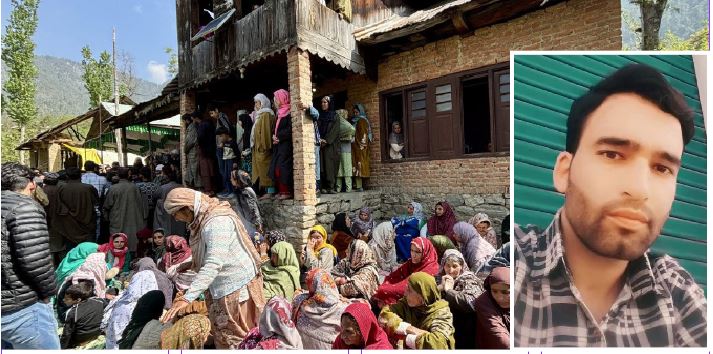Adil Hussain offered tourists horse rides to Baisaran and other places in the south Kashmir health resort.
Sitting in the corner of a dimly lit room, 55-year-old Baby Jan, sheds silent tears as she waits for the body of Syed Adil Hussain, her eldest son who was among 26 victims of the Pahalgam attack.
Adil, whose only newborn daughter passed away recently, was the lone Kashmiri civilian who was killed in the attack in the south Kashmir resort on Tuesday (April 22), and the circumstances in which he was killed perhaps hold the key to understanding the motivation of the attackers.
“We are not mourning the demise of Adil alone,” Khalida Parveen, Adil’s aunt, told The Wire, weeping incessantly, “We are crying for all those tourists who were killed in Pahalgam. The whole of Kashmir is in mourning. The government should not rest till the perpetrators are punished”.
Adil’s mother Jan, who speaks only in the Gojri language, said that her son left home – Hapatnar village of Anantnag district – on Tuesday morning for Pahalgam where he worked for daily wages. Adil offered tourists horse rides to Baisaran and other places in the south Kashmir health resort.
“The owner of the horse gave him Rs 300-400 per day. ̛In winter, he used to go and work in Jammu. This is how he has been sustaining our family. I don’t know how we are going to survive without him. Our world has turned upside down,” Jan said.
Adil’s father, Syed Haider Hussain Shah, said that his second son, Syed Nowshad Hussain, who works as a private driver in Pahalgam, phoned him at around 4 pm on Tuesday, asking whether Adil had gone to work.
Due to the nature of their work, Adil used to return home to Hapatnar every evening while his brother Nowshad often stayed back at the resort because tourists would return late to their hotels.
“I felt something was wrong and phoned Adil but he didn’t answer. Then, one of my nephews who also works in Pahalgam phoned to say that Adil had been injured in the attack. It was later in the evening, at around 10 pm, that we got to know that Adil was no more,” said Shah.
While Adil’s death is in contrast to claims that the attackers singled out Hindu tourists before killing them, it points to a possible overarching motivation – to destroy the valley’s tourism sector.
Speaking with The Wire, Abdul Waheed Wani, president of ponywallah association in Pahalgam, said that he reached the site of the massacre in Baisaran some 45 minutes after the incident took place.
The popular offbeat meadow at the end of a rugged, seven-kilometre trail from main Pahalgam is not serviced by road and the only way to reach there is by foot, on a horseback or in a chopper.
“I called the local police to stop sending tourists to Baisaran,” Wani said, “Bodies were scattered all over the meadow. We hauled the injured on horseback and sent them to Pahalgam from where they were sent to different hospitals. There were around 1,000-1,500 people in the area when the attack took place”.
Wani added: “It is like a hailstorm hitting a blooming garden. Hundreds of people in Pahalgam earned a livelihood by working in the tourism sector. The attack is going to destroy our livelihood”.
According to reports, a Nepali national is among 26 victims who were killed in the attack. Seventeen more are injured, two of them critically.
A pony rider, who was present in Baisaran at the time of the attack, said that the firing lasted for five to seven minutes and the tourists were targeted randomly by the perpetrators who are believed to be members of The Resistance Front, an offshoot of Pakistan-based Lashkar-e-Tayyaba outfit.
“I could hear screams and ran from cover. I didn’t see the attackers but tourists were running everywhere. Many tourists fell down and suffered injuries because they could not keep pace with the running crowd,” he said, wishing to stay anonymous.
As Adil’s family waited for his body to return home on Wednesday, haunting silence prevailed in the village. In the lawn of the bereaved family’s rundown, single-storey house, hundreds of young and old men and women gathered to console his father, mother and sisters while neighbours and relatives made preparations for a funeral.
On one side of the house, men milled around in groups of dozens and spoke in hushed tones with each other while women sat on jute mats rolled out across the lawn on the other side of the house, shedding tears in silence.
The dilapidated building was brimming with mourners and even the small flight of broken stairs which led into the house was occupied. From the window of the house’s wooden attic, a young girl craned out her neck while wiping her tears with her headscarf.
“This young woman had come to this house with her groom,” Parveen, Adil’s aunt said, referring to Adil’s wife. “Now she is waiting for his body.”
Courtesy: The Wire
